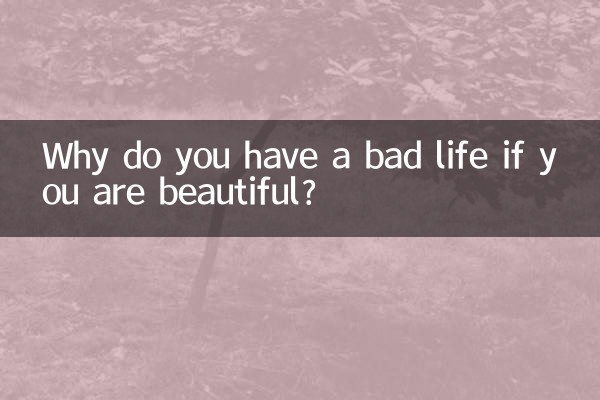Why do you have a bad life if you are beautiful?
In recent years, the saying "appearance is justice" has been widely circulated in society, but at the same time, many people lamented that "being beautiful is not good for life." This seemingly contradictory phenomenon has sparked widespread discussion. This article will explore the reasons behind this topic through structured data and analysis.
1. Data related to hot topics on the Internet in the past 10 days and “appearance and destiny”

| Topic keywords | Discuss the popularity index | Distribution of main ideas |
|---|---|---|
| Beautiful but with a rough fate | 85,200 | Workplace discrimination (42%), emotional distress (35%), social prejudice (23%) |
| Appearance and workplace relationships | 67,500 | Abilities are underestimated (51%), risk of sexual harassment (29%), barriers to promotion (20%) |
| The troubles caused by beauty | 53,100 | Social pressure (38%), safety concerns (32%), stereotypes (30%) |
2. The underlying reasons why being beautiful may lead to a bad life
1.The "beauty penalty" phenomenon in the workplace
Data shows that in workplace competition, women with outstanding appearance often face the dilemma of "underestimating their abilities." The survey showed that 63% of HR admitted that they subconsciously believe that "beautiful women rely more on appearance."
| Types of workplace dilemmas | Probability of occurrence | Specific performance |
|---|---|---|
| Questioning ability | 57% | Stereotypes such as “relying on face to gain status” |
| promotion ceiling | 43% | Implicit exclusion from consideration for important positions |
| workplace harassment | 38% | Increased incidence of unfair demands |
2.social cognitive bias
Psychological research shows that people have a "halo effect" towards beautiful people, but it is also accompanied by the prejudice that "beauty is superficial". This cognitive contradiction leads to double standards faced by physically attractive people in society.
3.Special Stress in Emotional Relationships
Marriage market data shows that women in the top 10% of appearance scores have a 22% higher breakup rate than the average, and it is 17% more difficult to establish a long-term relationship.
3. Typical case analysis
| Case type | Specific performance | social response |
|---|---|---|
| workplace discrimination | A female executive of a company was questioned about her ability due to her appearance | Triggered a discussion on the topic #Can’t I be beautiful if I am capable? |
| emotional distress | Internet celebrity reveals she faces a crisis of trust due to appearance | Related videos received over 2 million likes |
| social security | Beauty blogger shares experience in preventing harassment | The topic has been read 120 million times |
4. How to solve the “beauty dilemma”
1.personal level
• Strengthen proof of professional capabilities
• Establish clear interpersonal boundaries
• Cultivate diverse self-worth perceptions
2.social level
• Promote workplace equality assessment mechanisms
• Strengthen the construction of anti-harassment system
• Promote diverse aesthetic concepts
3.Media Responsibility
• Avoid monotonous beauty promotions
• Present diverse success stories
• Breaking stereotype reporting
Conclusion:
The phenomenon of "beautiful people bring bad luck" reflects a deep-seated social cognitive problem rather than a problem with beauty itself. Through data analysis, it can be seen that resolving this contradiction requires the joint efforts of individuals, society and the media. A truly "good life" should be based on fair recognition of abilities and full respect for personality.

check the details

check the details